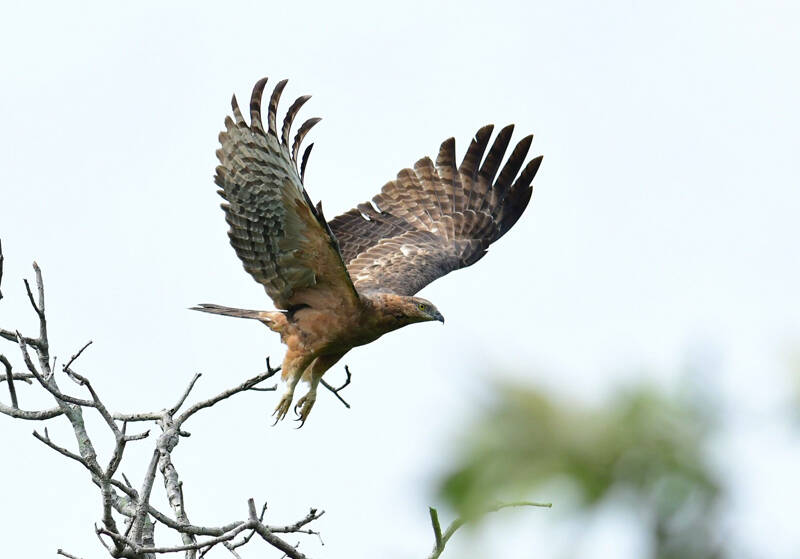Pernis ptilorhynchus
IUCN
LCBasic Information
Scientific classification
- name:Pernis ptilorhynchus
- Scientific Name:Pernis ptilorhynchus,Oriental Honey-buzzard,Octagonal eagle, eagle-headed eagle, honey eagle, oriental honey eagle
- Outline:Raptor
- Family:Falconiformes Accipitridae S.Melanophorinae G.Melanophora
Vital signs
- length:50-60cm
- Weight:1-1.8kg
- lifetime:20-50years
Feature
The sides of the head have short, hard, scaly feathers that are thick and dense.
Distribution and Habitat
The world is distributed in Bangladesh, Bhutan, Brunei, Cambodia, China, India, Indonesia, Iran, Islamic Republic, Japan, Kazakhstan, South Korea, North Korea, Kuwait, Laos, Malaysia, Maldives, Myanmar, Nepal, Pakistan, Philippines, Russian Federation, Singapore, Sri Lanka, Tajikistan, Thailand, East Timor, United Arab Emirates, Vietnam.
Migrant bird: Egypt, Israel, Jordan, Macau, Mongolia, Oman, Saudi Arabia, Turkey, Uzbekistan, Yemen.
Uncertain distribution: Afghanistan.
It breeds in Xiaoxing'anling, Dandong, Chaoyang and other places in Northeast China; it is a summer migratory bird or migratory bird in Nanchong, Emei, Sichuan, Tengchong, Lijiang and Xishuangbanna, Yunnan; it is seen in Kashgar, Xinjiang, Hebei, Yantai, Qingdao, Jiangsu, Fujian, Xining, Qinghai, Yunnan, Jinsha, Guizhou, Guangxi, Guangdong and other places during migration; it is a rare winter migratory bird in Taiwan and Hainan.
It lives in broad-leaved forests, coniferous forests and mixed forests
Appearance
The top of the head is dark brown to black brown, and the side of the head has short, hard, scaly feathers, which are relatively thick and dense, which is one of its unique characteristics. The occipital part of the head usually has a short black crest, which makes it look distinctive. The iris is golden yellow or orange-red and very beautiful. The beak is black, the feet and toes are yellow, and the claws are black. The upper body is usually dark brown, the head side is gray, the throat is white, and has a black central stripe. The rest of the lower body is tan or chestnut brown, with light reddish brown and white horizontal bands and a thick black central stripe. The primary flight feathers are dark gray with black tips, the underwing feathers are white or gray with black transverse bands, and the tail feathers are gray or dark brown with 3-5 dark broad stripes and gray-white wavy transverse stripes. The body color of the Crested Beehawk varies greatly, but it can be distinguished fr
Details
Oriental Honey-buzzard is a medium-sized bird of prey with 6 subspecies.

Some of the Crested Honey-buzzards are resident birds, while others are migratory birds, but both are relatively rare. Except for Hainan Island, all the birds distributed in China are summer migrants. They migrate here in spring from early April to late April and migrate away in autumn from late September to late October. They usually move alone, but occasionally gather in small groups in winter. They are agile and distinctive in flight, mostly flapping their wings. After flapping their wings several times, they glide for a long time, with their wings stretched out and soaring high in the sky. They often flap their wings quickly from one tree to another, and occasionally soar over the forest, or glide slowly, calling while flying, with short calls like whistles. Sometimes they are also seen resting on the treetops of tall trees or on the branches at the bottom of trees in the forest.
Crested honey buzzards like to build nests on tall trees, mostly using dead branches and leaves as nest materials, and sometimes using old nests of buzzards or goshawks. They lay eggs from late May to June, with 2-3 eggs per nest, which are light gray-yellow with reddish-brown spots. The incubation period is 30-35 days, and the brooding period is 40-45 days. The breeding period is from April to June. When courting, the male and female birds glide in the air together, then descend rapidly, and then slowly circle, with their wings folded 6-7 times behind their backs. They nest on broad-leaved or coniferous trees, 10-28 meters above the ground. The nest is mainly made of dead branches, slightly concave in the middle, in a disc shape, with a few grass stems and leaves inside. Sometimes old nests of other birds of prey such as kites and goshawks are also used. Each nest lays 2-3 eggs, usually 2. The eggs are brick red or yellow-brown with coffee-colored spots.
Deforestation has caused a certain degree of damage to the nesting sites of the Crested Honey Buzzard, and indiscriminate hunting during the migration period is the main factor affecting the number of Crested Honey Buzzards.
Some people believe that the Crested Honey Buzzard preys on bees and should be listed as a pest. In fact, its main prey is not domesticated bees, but wild bees. In particular, it also eats some forest pests and animals. Only some individuals living near apiaries will cause a small amount of loss to the beekeeping industry. Therefore, the Crested Honey Buzzard, like other raptors, is also a bird that is beneficial to humans.
Listed in the "Red List of Endangered Species of the World Conservation Union" (IUCN) 2016 ver3.1-Least Concern (LC).
Listed in the "Washington Convention" CITES Appendix I endangered species.
Listed in the second level of China's "National Key Protected Wildlife List" (February 5, 2021).
Protect wild animals and stop eating game.
Maintaining ecological balance is everyone's responsibility!








